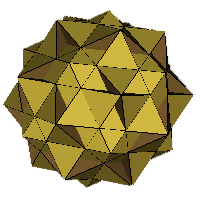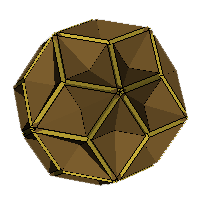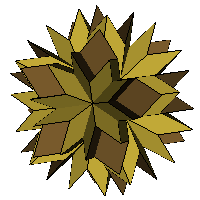 1. Relaxed duals to semi- truncated uniform polyhedra
|
 2. Relaxed Duals of semi-truncated augmented Platonic and Kepler-Poinsot Polyhedra |
 3. Relaxed Duals of Augmented Trivalent Uniform Polyhedra |
Bi-rhombic Polyhedra with Icosahedral Symmetry
 1. Relaxed duals to semi- truncated uniform polyhedra
|
 2. Relaxed Duals of semi-truncated augmented Platonic and Kepler-Poinsot Polyhedra |
 3. Relaxed Duals of Augmented Trivalent Uniform Polyhedra |
The discovery of the great rhombic enneacontahedron led me to enquire as to whether other similar polyhedra exist.
Simple examples
Turning briefly to convex polyhedra meeting the above criteria: there are two cases, the rhombic triacontahedron and the rhombic enneacontahedron. Both are discussed on their own pages.
There are also a number of qualifying polyhedra which are monorhombic (i.e. face transitive on all faces), these are discussed on my page "Isohedral Rhombohedra". In a number of cases these were formed by relaxing the duals of uniform polyhedra with tetravalent vertices.
Turning to examples of qualifying rhombohedra with two sets of faces (which I term 'birhombic polyhedra): the great rhombic enneacontahedron is also discussed on its own page, trivial cases can be formed by augmenting or excavating the isohedral rhombohedra with rhombic prisms. The lateral square faces and the capping rhombic faces forming the two sets of rhombi. These examples are not considered further.
New examples
A number of further examples have been generated. The method of generation will be discussed below. It is interesting to note though the limited number of distinct acute angles that occur in the rhombi discovered to date. Acute angles have been so far limited to the following values:
where tau = (sqrt(5)+1)/2
A polyhedron with rhombic faces will be dual to a polyhedron with all vertices tetravalent. This dual can then potentially be relaxed such that all faces become rhombi. It should be noted that the extent of the relaxation can in some cases be significant. The originating dual should be regarded as no more than a start point for the relaxation process. The resulting rhombic polyhedron is isomorphous to the original dual but should not be thought of as having any greater relationship than this.
Tetravalent uniform polyhedra have been discussed above. To generate further examples of tetravalent polyhedra, and this the potential for further birhombic polyhedra, the following processes were used:
1. Relaxed duals to semi-truncated uniform polyhedra
The act of semi-truncating any polyhedron results in a tetravalent polyhedron. Semi-truncation is the process of replacing each vertex of a polyhedron with a face whose vertices are the mid-points of the edges of the original polyhedron which are adjacent to that original vertex. Looking at this from the perspective of an edge of the original polyhedron, the two adjacent faces are supplemented by two new faces which have replaced the vertices at each end of the original edge. The dual to a semi-truncated polyhedron will thus have quadrilateral faces which can then potentially be relaxed to form rhombi.
This process was performed on all uniform polyhedra with icosahedral symmetry. In the majority of cases a valid birhombic polyhedron could not be formed for one or more of the following reasons
Those cases for which a valid birhombic polyhedron was created are presented below:
|
|
|
|
|
|
2. Relaxed Duals of semi-truncated augmented Platonic and Kepler-Poinsot Polyhedra
In addition to the duals of semi-truncated uniform polyhedra above, a number of the Platonic and Kepler-Poinsot polyhedra can be augmented (or excavated) with pyramids prior to the process of forming the dual and its subsequent relaxation.
|
|
|
|
|
|
3. Relaxed Duals of Augmented Trivalent Uniform Polyhedra
A trivalent uniform polyhedron can be augmented or excavated with cupolae. The original trivalent vertices become tetravalent, the new vertices (adjacent to the small face of the cupola are also tetravalent. The dual to this figure has quadrilateral faces which fall into two sets (as the augmented polyhedron has two types of vertex). In a number of cases these figures can be 'relaxed' such that the faces become rhombi. The cupolae can be placed in one of two orientations, potentially giving rise to two solutions.
My naming convention for these polyhedra is as follows:
Relaxed dual of [Base Polyhedron] with {n} augmented with cupolae case [1 or 2]
3.1 Examples based on the Truncated Icosidodecahedron (or "tid")
|
|
|
|
|
|
3.2 Examples based on the Icositruncated Dodecadodecahedron (or "idtid")
|
|
|
|
|
Relaxed dual of idtid with {10} augmented with cupolae case 2 contains coplanar edge adjacent faces
|
Examples based on {10/3} augmentation/excavation could not be formed
3.3 Examples based on the Truncated Dodecadodecahedron (or "quitdid")
|
|
contains coplanar edge adjacent faces |
Examples based on {10/3} augmentation/excavation could not be formed
3.4 Examples based on the Great Truncated Icosidodecahedron (or "gaquatid")
|
|
|
Relaxed dual of gaquatid with {10/3} augmented with cupolae gives same results as for tid.
As in certain other pages on this site, this is not intended as a complete list of qualifying polyhedra, it is merely a catalogue of examples I have discovered to date. I would be very surprised to learn that the list was complete. Contributions are welcome.
Credits: The original duals were produced using Great Stella converted using Hedron Tools and relaxed to produce the above switch VRMLs using HEDRON.